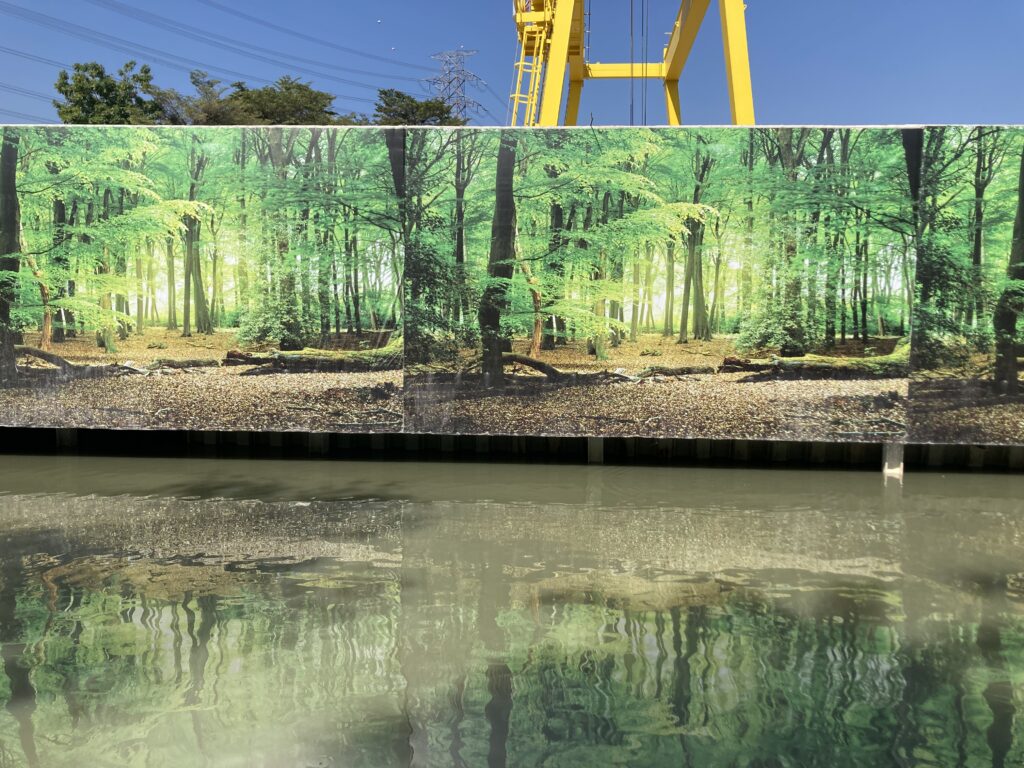The ripe smell of decay works its way through the air conditioners just as I begin to see signs for ‘The Rot Garden.’ I assume enough time has passed since incident at ‘The Root Garden’ that anybody who noted me as a visitor would have forgotten my face and I wouldn’t become entwined in what, as far as I can tell, it a name-based turf war between two totally different locations. The signs are not what I expect from the grunge punk food attack that occurred at ‘The Root Garden.’ In fact, the advertising tone is nearly identical to that of ‘The Root Garden-’ emphasizing natural processes and a side of nature few get to see. ‘The Rot Garden’ does capitalize on gross-out humor in its illustrations, however, showcasing rotting fruit covered in flies, old skeletons dancing in muck, and an earthworm mascot that pleads for visitors to his home.
Only very late and in very small print do any signs mention you might consider eating some of this.
‘It’s just like cheese, they tell you. It’s like yogurt! Or, ah, pickles!
‘The Rot Garden’ and every funny-food destination like it will go to great lengths to make their menu seem appetizing by way of comparison, but the fact that they’re needing to compare at all tends to set them apart. ‘The Rot Garden’s’ more modern, and somehow more persuasive, take is to associate itself with those fringe health movements that, in neglecting large swaths of the food pyramid, resort to fermentation for the natural bacteria the body needs. This includes the all-fruit and all-meat ilk, both of whom will be happy enough with the offerings of ‘The Rot Garden,’ which certainly has bacteria on hand.’
‘The Rot Garden’ is largely open air: a field, a dump, really, with the odd open-air shelter where one might sit and eat. A very small adobe structure rises from the ground in the distance: a cellar, of sort, for encouraging different kinds of rot. A tin shack stands at the entrance, for selling tickets. The perimeter is marked by sun-bleached dumpsters and a cloud of insects fogs the air above.
It all smells terrible.
The man in the shack may very well be one of the people who participated in the attack at ‘The Root Garden.’ He’s wearing a leather jacket and a band tee that’s faded and cracked to such an extent that I can’t read it. He reeks of body odor when he shifts, which is somehow a reprieve from the smell of the place at large. A living stench.
“One please.” I tell him as he looks behind me.
“Cool camper,” he says, “You going to be eating?”
“Uh… is it recommended?”
The man suppresses a smile: “Of course.”
My stomach sinks. “Then maybe something small.”
“That actually makes the ticket cheaper.” He presses a stamp down on the ticket and hands it to me. “We like to encourage people to push their boundaries.”
The tour itself is largely unnecessary. Unlike ‘The Root Garden,’ which reiterated much of what I already knew, the couple that walks me around ‘The Rot Garden’ points out especially nasty molds and insects and describes some of the intersocial drama between employees, including a boss they don’t name but who will disappear for weeks at a time and then reappear with, say, a truck full of soft pumpkins. They don’t seem particularly reverent of the place as an institution or a biome. They swat flies and complain that the boss won’t let them use spray.
Finally they bring me to a picnic table where four more employees join us. A tray with three divisions has been plated with small portions of rotting food: an apple, a strip of unidentifiable meat, and a cream that I hope is yogurt.
“Eat up, man.” The guy from the front hands me a fork. “You want a picture? It’s included.”
I hardly hear him. “Sure.”
After several seconds hesitation, I dip the tines of the fork into the cream and cringe to see that its white surface gives way to something swirled red. I bring the fork to my mouth and, as it hits my tongue, the flash of a camera goes off and the six employees recoil.
“Oh my god, he did it!”
“That’s fucking nasty”
One of the men turns to throw up. The others hold their faces or slap me on the back. By the time I’ve had a chance to indicate I’m done, I realize I never had time to taste whatever they just fed me.
On the way out of ‘The Rot Garden,’ the man tacks my picture to the wall of fame. It’s not a bad picture, but it’s the only one there.
-traveler





